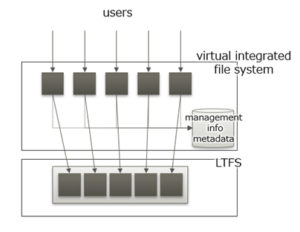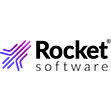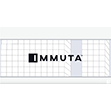
Fujitsu Develops Magnetic Tape Storage High-Speed Access Technology
KAWASAKI, Japan, March 4, 2020 — Fujitsu Laboratories Ltd. today announced the development of high-speed access technology for magnetic tape storage, which is attracting renewed interest as a low-cost, large-capacity storage solution alternative to hard disks (HDD).
Traditionally, magnetic tape storage has been used mainly for backup purposes, but because of its high capacity and low cost, as well as the acceleration of transfer speeds and the spread of the Linear Tape File System (LTFS) in recent years, it is expected to find increasing use for archival purposes.
Fujitsu has successfully expanded the functionality of LTFS by innovating a unique file system that virtually integrates multiple tape cartridges. By improving random read performance from tape through data management and access order control in accordance with tape characteristics, the new technology successfully achieves speeds 4.1 times faster than conventional methods.
This technology will accelerate the adoption of magnetic tape storage technology as an archival medium in anticipation of the exponential growth of data in the future. By promoting this technology, Fujitsu will help companies to achieve their digital transformation goals through data storage solutions that offer superior performance at a reasonable cost. Fujitsu Laboratories is currently conducting a verification trial assuming the application of this technology to its operations, with plans to commercialize the technology by the end of fiscal year 2022.
Details of this technology will be presented at the 12th Forum on Data Engineering and Information Management (DEIM 2020), which will be held from March 2nd to March 4th.
About the Newly Developed Technology
While magnetic tape storage is ideally suited to reading from and writing to sequential areas of tape, its ability to randomly access discontinuous locations remains limited. The technology’s relative inability to deliver random access reading presents a roadblock to broadening its use into high volume data archiving applications.
In general, to manage a large amount of data with magnetic tape storage, data is held under a different directory for each tape cartridge on LTFS, which uses multiple tape cartridges and can access data on a file-by-file basis in the same way as data on HDDs, USB memory, etc.
Fujitsu developed a new file system on LTFS that virtually integrates multiple tape cartridges. This virtually integrated file system consolidates multiple tape cartridges into one, allowing users to access the data they need without thinking about each individual tape cartridge. In addition, the following newly developed technologies have been applied to this file system to achieve high-speed magnetic tape access performance.
1. Access Order Control with Physical Location
On a magnetic tape, data is divided along its length in units called wraps, and each wrap wraps around and is written in a write-once fashion. Therefore, the distance between the logical address and the physical address is very different. The virtual consolidated file system accepts multiple random read requests and processes them starting with the closest physical location on the tape, not the logical address.
When writing to magnetic tape, write and error checking are performed in parallel, and when an error occurs, only the part of the error that occurred after the end of writing is automatically rewritten. Therefore, it is difficult to predict the physical location where a rewrite has finished from the change in file size. The physical location of each file is estimated by periodically measuring the head position after writing the file.
Also, when accessing the magnetic tape, it takes time to align the head to the start position. Therefore, two read requests that are close to each other on the same wrap will not read two files at once, but will read all the files in between and discard unnecessary files.
2. Multiple File Aggregation Function
LTFS maintains an index of each file on magnetic tape, and the impact increases exponentially as the number of files increases. When using tapes for archival purposes, users write and access files of various sizes, but writing large numbers of small files can significantly degrade read performance.
Therefore, Fujitsu has developed a mechanism to keep small files smaller than a specified file size together as large files on LTFS so that users can access them without worrying about the location of the files. In addition, by managing the metadata of user files in the virtual integrated file system, it is possible to quickly display a list in a way other than data reading, add extended attributes, or delete files without accessing the magnetic tape.
Outcomes
Fujitsu has constructed a hierarchical storage system for HDDs and magnetic tapes by using Ceph (1), an open source distributed storage software, and evaluated the access performance of the system. As a result, the time required to read 100 files randomly from a total of 50,000 individual 100 MB files stored on magnetic tape was 5,400 seconds with the conventional method. By using the new technology, it was possible to confirm a read in 1,300 seconds, which is 4.1 times faster than the conventional method. In addition, while the conventional method required 2.5 seconds to move 256 individual 1 MB files on the HDD onto magnetic tape, the new technology enabled us to confirm data movement in 1.3 seconds, which is 1.9 times faster than the conventional method.
This technology enables high-speed tape access performance, such as random reads and writes of various sizes occurring in archive applications, and is expected to provide a cost-effective data archiving infrastructure for long-term archiving of large volumes of data.
- [1] Ceph — Open source distributed storage software developed at the University of California and managed by the Ceph community since 2004.
About Fujitsu Laboratories
Founded in 1968 as a wholly owned subsidiary of Fujitsu Limited, Fujitsu Laboratories Ltd. is one of the premier research centers in the world. With a global network of laboratories in Japan, China, the United States and Europe, the organization conducts a wide range of basic and applied research in the areas of Next-generation Services, Computer Servers, Networks, Electronic Devices and Advanced Materials. For more information, please see: http://www.fujitsu.com/jp/group/labs/en/.
Source: Fujitsu Limited
August 26, 2025
- OpenLight Raises $34M Series A to Scale Next-Gen Integrated Photonics for AI Data Centers
- Domo Unveils Enhanced Cloud Integration Upgrades for Snowflake
- NVIDIA: Industry Leaders Transform Enterprise Data Centers for the AI Era with RTX PRO Servers
- Hydrolix Accelerates Growth with $80M Series C
- Ai2 Launches Asta: A New Standard for Trustworthy AI Agents in Science
- IDC: Agentic AI to Dominate IT Budget Expansion Over Next 5 Years, Exceeding 26% of Worldwide IT Spending, and $1.3T in 2029
August 25, 2025
- Fivetran and S3NS Partner to Bring Secure Data Movement to Regulated Industries Across Europe
- Lightbits to Showcase Software-Defined Storage for OpenShift at Red Hat Connect
August 22, 2025
- Definite Raises $10M Seed Round to Deliver AI-Native Data Stack for Modern Businesses
- SurrealDB Launches SurrealMCP, Bringing AI Agents Secure, Real-Time Memory
- Domino Data Lab Expands Strategic AI Partnership with UBS
- Transcend Expands ‘Do Not Train’ and Deep Deletion to Power Responsible AI at Scale for B2B AI Companies
- TinyFish Launches with $47M to Define the Era of Enterprise Web Agents
August 21, 2025
- Salesforce Signs Definitive Agreement to Acquire Regrello
- Learn AI Skills Through the SAS Hackathon
- Elemental Machines Launches Flexible, Multitiered Business Intelligence Platform to Expand Lab Data Insights
- EDB Research Highlights Energy and Cost Savings for Fortune 500 Firms
- CVector Raises $1.5M in Pre-Seed Round Led by Schematic Ventures to Launch the Data Backbone for Industrial AI
- Esri Releases Practical New Guide to Creating Visually Stunning and Effective Map Apps
- Appian’s Latest Platform Release Delivers Enterprise-Ready AI
- Rethinking Risk: The Role of Selective Retrieval in Data Lake Strategies
- Why Metadata Is the New Interface Between IT and AI
- LinkedIn Introduces Northguard, Its Replacement for Kafka
- What Are Reasoning Models and Why You Should Care
- Why OpenAI’s New Open Weight Models Are a Big Deal
- LakeFS Nabs $20M to Build ‘Git for Big Data’
- What Is MosaicML, and Why Is Databricks Buying It For $1.3B?
- Doing More With Your Existing Kafka
- Beyond Words: Battle for Semantic Layer Supremacy Heats Up
- Meet Vast Data CEO Renen Hallak, a 2024 BigDATAwire Person to Watch
- More Features…
- Mathematica Helps Crack Zodiac Killer’s Code
- BigDATAwire Exclusive Interview: DataPelago CEO on Launching the Spark Accelerator
- Promethium Wants to Make Self Service Data Work at AI Scale
- Solidigm Celebrates World’s Largest SSD with ‘122 Day’
- McKinsey Dishes the Goods on Latest Tech Trends
- GigaOm Rates the Object Stores
- The Top Five Data Labeling Firms According to Everest Group
- Google Pushes AI Agents Into Everyday Data Tasks
- Oracle Launches Exadata Service for AI, Compliance, and Location-Critical Workloads
- AI Skills Are in High Demand, But AI Education Is Not Keeping Up
- More News In Brief…
- Seagate Unveils IronWolf Pro 24TB Hard Drive for SMBs and Enterprises
- Gartner Predicts 40% of Generative AI Solutions Will Be Multimodal By 2027
- LF AI & Data Foundation Hosts Vortex Project to Power High Performance Data Access for AI and Analytics
- Deloitte Survey Finds AI Use and Tech Investments Top Priorities for Private Companies in 2024
- Dell Unveils Updates to Dell AI Data Platform
- Stack Overflow’s 2025 Developer Survey Reveals Trust in AI at an All Time Low
- Redpanda Partners with Databricks to Deliver One‑Step Stream‑to‑Table Iceberg Integration for Real‑Time Lakehouses
- Computing Community Consortium Outlines Roadmap for Long-Term AI Research
- Sisense Announces $100M+ Funding Round at More Than $1B Valuation
- Bloomberg Integrates Natural Language Search Across Terminal Research Content
- More This Just In…











































